
Blickling Hall is a Jacobean stately home situated in 5,000 acres of parkland in a loop of the River Bure, near the village of Blickling north of Aylsham in Norfolk, England. The mansion was built on the ruins of a Tudor building for Sir Henry Hobart from 1616 and designed by Robert Lyminge. The library at Blickling Hall contains one of the most historically significant collections of manuscripts and books in England, containing an estimated 13,000 to 14,000 volumes. The core collection was formed by Sir Richard Ellys. The property passed into the care of the National Trust in 1940.

A shrubbery, shrub border or shrub garden is a part of a garden where shrubs, mostly flowering species, are thickly planted. The original shrubberies were mostly sections of large gardens, with one or more paths winding through it, a less-remembered aspect of the English landscape garden with very few original 18th-century examples surviving. As the fashion spread to smaller gardens, linear shrub borders covered up walls and fences, and were typically underplanted with smaller herbaceous flowering plants. By the late 20th century, shrubs, trees and smaller plants tend to be mixed together in the most visible parts of the garden, hopefully blending successfully. At the same time, shrubs, especially very large ones, have become part of the woodland garden, mixed in with trees, both native species and imported ornamental varieties.
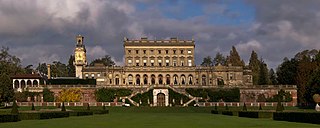
Cliveden is an English country house and estate in the care of the National Trust in Buckinghamshire, on the border with Berkshire. The Italianate mansion, also known as Cliveden House, crowns an outlying ridge of the Chiltern Hills close to the South Bucks villages of Burnham and Taplow. The main house sits 40 metres (130 ft) above the banks of the River Thames, and its grounds slope down to the river. There have been three houses on this site: the first, built in 1666, burned down in 1795 and the second house (1824) was also destroyed by fire, in 1849. The present Grade I listed house was built in 1851 by the architect Charles Barry for the 2nd Duke of Sutherland.

An arboretum is a botanical collection composed exclusively of trees of a variety of species. Originally mostly created as a section in a larger garden or park for specimens of mostly non-local species, many modern arboreta are in botanical gardens as living collections of woody plants and is intended at least in part for scientific study.

Standen is an Arts and Crafts house located to the south of East Grinstead, West Sussex, England. The house and its surrounding gardens belong to the National Trust and are open to the public. It is a Grade I listed building.
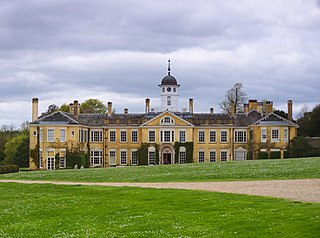
Polesden Lacey is an Edwardian house and estate, located on the North Downs at Great Bookham, near Dorking, Surrey, England. It is owned and run by the National Trust and is one of the Trust's most popular properties.

Avenue House is a large Victorian mansion situated on East End Road in Finchley in the London Borough of Barnet.

Wakehurst, previously known as Wakehurst Place, is a house and botanic gardens in West Sussex, England, owned by the National Trust but used and managed by the Royal Botanic Gardens, Kew. It is near Ardingly, West Sussex in the High Weald, and comprises a late 16th-century mansion, a mainly 20th-century garden and, in a modern building, Kew's Millennium Seed Bank. Visitors are able to see the gardens, the Mansion, and also visit the seed bank. The garden today covers some 2 km2 and includes walled and water gardens, woodland and wetland conservation areas.

Bodnant Garden is a National Trust property near Tal-y-Cafn, Conwy, Wales, overlooking the Conwy Valley towards the Carneddau mountains.

Bailey Arboretum is a 42-acre (17 ha) arboretum located in Lattingtown, New York, a small village on the North Shore of Long Island. It opened to the public on Aug. 5, 1969 after being donated to Nassau County in 1968 by the heirs of Mr. and Mrs. Frank Bailey. Through an agreement with the Village of Lattingtown, admission to the arboretum was limited to 200 people at any one time.
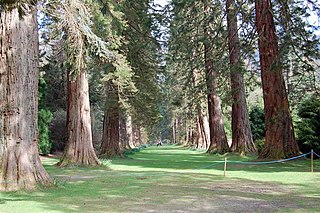
Benmore Botanic Garden is a large botanical garden situated in Strath Eachaig at the foot of Beinn Mhòr, on the Cowal peninsula, in Argyll and Bute, Scotland. The gardens are on the west side of the A815 road from Dunoon, between the Holy Loch and Loch Eck, and include footbridges across the River Eachaig. It is one of the sites of Royal Botanic Garden Edinburgh.
Government House is the official residence of the governor of Bermuda. It is located on Langton Hill, overlooking the North Shore in Hamilton, Pembroke. Government House is also the official residence of the Bermudian head of state when staying in Bermuda.
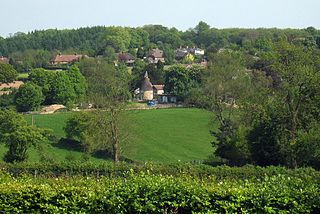
Sundridge and Ide Hill is a civil parish in the Sevenoaks District of Kent, England. It is located in the Darenth valley and lies between Sevenoaks and Westerham. The parish contains the villages of Sundridge and Ide Hill and the hamlet of Goathurst Common. It lies within the Kent Downs Area of Outstanding Natural Beauty and within London's Metropolitan Green Belt. It is approximately 21 miles south of London.

The Wadsworth Mansion at Long Hill Estate is located at 421 Wadsworth Street in Middletown, Connecticut. It is a 16,000-square-foot (1,500 m2) classical revival house situated on 103 acres (0.42 km2) wooded area. It is currently owned by the City of Middletown and is operated by the Long Hill Estate Authority. The mansion is the centerpiece of the Wadsworth Estate Historic District of 270 acres (1.1 km2), which includes the mansion's associated outbuildings, the Middletown portion of Wadsworth Falls State Park, the Nehemiah Hubbard House, and several barns and farmhouses along Laurel Grove Road such as the Harriet Cooper Lane House.

Sayes Court was a manor house and garden in Deptford, in the London Borough of Lewisham on the Thames Path and in the former parish of St Nicholas. Sayes Court once attracted throngs to visit its celebrated garden created by the seventeenth century diarist John Evelyn. Now completely buried beneath Convoys Wharf and Sayes Court Park, the area shows little sign of its former glory, despite having been a key factor in the creation of the National Trust.

Doddington Place Gardens is part of a 850 acres (3,400,000 m2) Edwardian estate, located on the edge of Doddington village, near Faversham in Kent, UK.
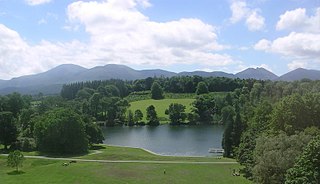
Castlewellan Forest Park is located in the town of Castlewellan in County Down, Northern Ireland.

How Hill House is a large Edwardian house in How Hill, an area of Ludham parish, Norfolk, England. The house overlooks the River Ant and is within the Broads National Park. The house was designed in the vernacular revival style by the English architect Edward Thomas Boardman in 1903 who intended it to be his family's country retreat. The Boardman family owned the house until 1966 before its sale to Norfolk County Council. Years later it was sold to Norwich Union who eventually gifted the house to the How Hill Trust, an environmental education charity. The house is a Grade II listed building.
Charles Watson Boise was an American-born naturalised British mining engineer.
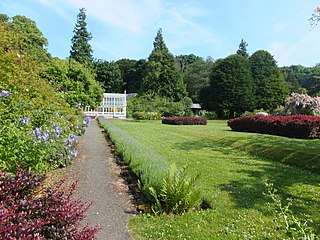
The Malleny House and Garden is an historic house and garden owned by the National Trust for Scotland in Balerno, 6 mi (9.7 km) southwest of Edinburgh. The gardens are notable for its large yew trees, as well as one of the largest rose collections in Scotland. According to Historic Environment Scotland, Malleny is noted for its outstanding architectural and horticultural value including its national collection of heritage shrub roses. The house, gardens and adjoining estate buildings are Category A listed.



















